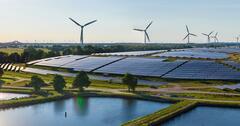

When you flip a light switch on, you expect an instant result. If everybody flipped a light switch on simultaneously, they would all expect instant results. A key factor that helps to determine whether people get the light they expect is if the electric generation sources that create the power for those many switches are “dispatchable” or not.
Dispatchable sources of electricity are those that can supply the power we need, when we need it. “When” and “how much” are the key concepts, because our power usage is constantly and rapidly fluctuating, and providers need to respond quickly to meet the demand. Dispatchable also refers to the amount of power being supplied, since overproducing in times of low usage is just as inefficient as underproducing in times of need.
Non-dispatchable sources are those that the companies providing electricity cannot control. Renewable energy sources, like solar power and wind power, are not consistent, nor are they controllable. The solar radiation that hits solar cells and produces electricity is affected by nightfall, cloud cover, and the geographical location of the cells. Likewise, the wind does not blow all the time. Wind currents are affected by air density and temperature, which vary throughout the day. And the wind must be neither too strong nor too weak for it to generate electricity.
Hydroelectric power is the most dispatchable source of energy. Flowing water can be made to power a turbine in a matter of seconds and is the most efficient way to produce electricity. Since the water captured behind a dam needs nothing more than gravity to ensure it will spin a turbine, it is available to produce electricity at a moment’s notice.
Nuclear and coal plants are dispatchable in that they are completely controllable. Once running, they affect the grid supply instantly and can be relied on to continue running consistently. These plants are typically used to provide baseload power — the always-on, minimum amount of electricity needed to meet the never-ending demand for electricity in a modern society. They supply the energy that runs our society, regardless of the weather or time of day.
But baseload generators may not always provide enough energy. A hotter-than-usual summer night would, for example, increase the demand for air conditioning. That increased demand would require more energy than normal, and quickly. This is where dispatchable energy comes in. Since nuclear and coal power plants are already meeting the minimum demands, other sources, such as natural gas, must step in quickly. When the amount of electricity a region requires returns to normal, a dispatchable source can be slowed or powered down, preventing overproduction.
Non-dispatchable sources, like wind and solar, do provide some energy. They can charge batteries when the sun is shining or the wind is blowing, and then use this power during times of peak energy usage. For example, the Crescent Dunes power plant in Nevada can hold 10 hours of energy when fully loaded. But solar energy is not equally useful in all areas, especially in a state like Michigan, which has less than half the total number of clear days that states like California, Nevada, Arizona and New Mexico receive.
Renewable energy sources augment the baseload power supplies of nuclear and coal, but since we can’t control the weather, they are not reliable sources of energy. To ensure that the lights come on with the switch is flipped, it’s best to have power sources that do not depend on the weather.
Permission to reprint this blog post in whole or in part is hereby granted, provided that the author (or authors) and the Mackinac Center for Public Policy are properly cited.
Get insightful commentary and the most reliable research on Michigan issues sent straight to your inbox.


The Mackinac Center for Public Policy is a nonprofit research and educational institute that advances the principles of free markets and limited government. Through our research and education programs, we challenge government overreach and advocate for a free-market approach to public policy that frees people to realize their potential and dreams.
Please consider contributing to our work to advance a freer and more prosperous state.

Donate | About | Blog | Pressroom | Publications | Careers | Site Map | Email Signup | Contact